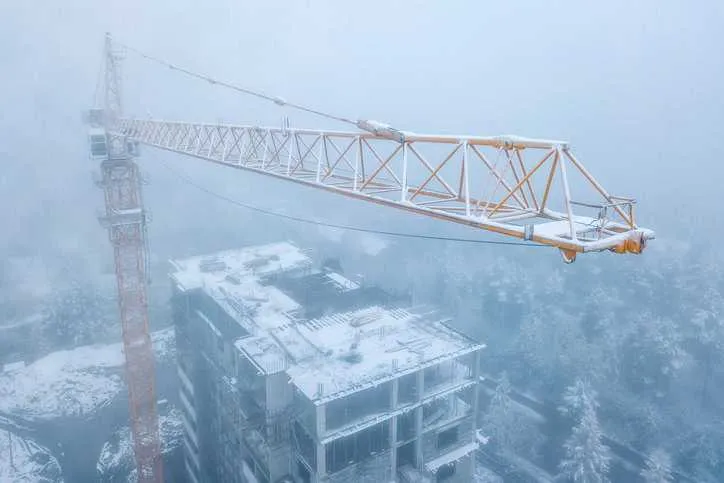Operating A Crane In Extreme Weather

Extreme weather happens everywhere, and construction operations must continue despite a lingering threat. High winds, hot temperatures, heavy rain, thunderstorms, and icy conditions can decrease visibility, increase the likelihood of equipment failure, and put construction workers at risk. By considering these weather patterns and the best practices for operating a crane within them, construction personnel can improve the safety of their routine tasks.
Extreme Weather Concerns
The type of weather affects the overall conditions and the hazards that crane operators face. By considering these specific extreme weather scenarios, construction sites can create plans to mitigate problems and minimize downtime.
High winds
High winds can blow loose debris around the jobsite and even move equipment in some cases. Wind can also make it harder for the crane to operate properly or safely. Cranes usually have a wind speed limitation set by the manufacturer. Construction personnel may need to add counterweights, outriggers, or other equipment to improve stability. Manufacturers provide information about how to safely operate the crane in moderately windy conditions, with different settings for land and sea operations. Installing wind sensors can help construction workers identify the conditions for proper handling as the weather changes.
Hot, dry weather
Hot, dry weather can pose several obstacles to crane operators and the equipment. Excessively hot conditions put operators at risk for heat-related illnesses, such as dehydration, heat exhaustion, or heat stroke. These conditions are not always easy to identify, and they can significantly affect a person’s ability to operate equipment safely. Additionally, equipment can overheat in very hot sun or high temperatures. To minimize the risk of either of these effects, site managers should consider scheduling crane operation for hours when the temperature is lower and stay on top of routine maintenance to reduce breakdowns.
Heavy rain
Heavy rain affects visibility and stability of the jobsite, which can turn a safer workspace into a dangerous one. Rain makes it harder for crane operators to see and can make soft ground slippery. When coupled with high winds, thunderstorms, or other weather types, rain also contributes to electrical outages, flooding, and other hazards. For crane operation during heavy rain, construction personnel should:
- Shelter the area to keep the ground and equipment dry
- Install protection for electrical boxes and connections
- Inspect equipment for signs of water damage
- Suspend operations during very heavy rain
These steps can improve productivity without compromising safety.
Thunderstorms
Thunderstorms create serious safety hazards for crane operators. Lighting can strike miles away from rain, and it does not always follow a predictable pattern. Cranes and other high-profile pieces of equipment are prone to drawing lightning, which underscores the need for installing lightning rods, lightning arresters, or other grounding equipment. OSHA recommends that jobsites temporarily cease outdoor operations when they can audibly hear thunder in the area. Practicing a weather-mitigation plan can help crane operators to quickly retract the crane arm and turn off the equipment without missing crucial steps.
Snow or cold
Snowstorms and very cold weather can make proper crane operation more difficult, requiring some adaptation. Construction site managers should consider the effects of the weather in terms of visibility, safe mobility, and equipment condition. Steps to take include evaluating the site for hazards, applying deicing solutions to crane equipment, and clearing walkways of snow and ice. Crane operators need frequent breaks and protective gear to maintain range of movement. For temperatures below freezing, crane operators should decrease the load according to manufacturer recommendations for icy weather.
How to Prevent Problems From Extreme Weather Conditions
A proactive plan can reduce the likelihood of negative effects resulting from extreme weather. When anticipating crane operations, construction managers should:
- Implement a plan to monitor weather patterns, including receiving alerts about weather that requires a change of jobsite activity
- Create an emergency response plan to address the most likely types of extreme weather, and practice these responses with workers on the site
- Evaluate the site regularly for hazards that can become worse in weather, such as open containers of solvents or loose debris
- Provide a current, maintained, and effective supply of personal protective equipment for crane operators
Preparing in advance can also reduce stress for operators because they know they have will have support.
Operating a crane when the wind is howling, the rain is coming down in sheets, or the ground is baked dry requires a specific plan. Formulating a response for each type of extreme weather can help crane operators to meet construction timelines without putting themselves at risk for injury.
Contributing Author: Annette Harris
Annette Harris has been with American Equipment for 23 years and in the industry for over 40. Her roles include Service Manager, Outside Service Sales and — most currently — Head of Sales Operations for American Equipment. She has a passion for service in the industry and loves to discover customers’ needs and find a solution for them.






